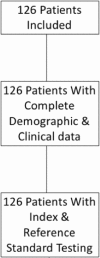Point-of-care testing for procalcitonin in identifying bacterial infections in young infants: a diagnostic accuracy study
- PMID: 30541505
- PMCID: PMC6292055
- DOI: 10.1186/s12887-018-1349-7
Point-of-care testing for procalcitonin in identifying bacterial infections in young infants: a diagnostic accuracy study
Abstract
Background: The primary objective of this study was to report on the diagnostic accuracy of point-of-care testing (POCT) for procalcitonin (PCT) in identifying invasive bacterial infections in young infants. Invasive bacterial infection was defined as the isolation of a bacterial pathogen in blood or cerebrospinal fluid culture.
Methods: This was a prospective observational diagnostic accuracy study. Young infants less than 90 days of age presenting to the Royal Belfast Hospital for Sick Children with signs of possible bacterial infection were eligible for inclusion. Eligible infants underwent point-of-care testing for procalcitonin in the emergency department. Testing was performed by clinical staff using 0.5 ml of whole blood. Results were available within 20 min.
Results: 126 children were included over a 5-month period between September 2017 and January 2018. There were 14 children diagnosed with bacterial infections (11.1%). Of these 4 children were diagnosed with invasive bacterial infections (3.2%). POCT procalcitonin demonstrated an excellent diagnostic accuracy for identifying children with invasive bacterial infection area under the curve (AUC) of 0.97(95% CI, 0.94 to 1.0). At a cut-off value of 1.0 ng/ml is highly accurate at identifying infants at risk of invasive bacterial infection with a sensitivity and specificity of 1.00 and 0.92 respectively.
Conclusions: Point-of-care procalcitonin can be performed quickly in the emergency department and demonstrates an excellent diagnostic accuracy for the identification of young infants with invasive bacterial infections.
Trial registration: NCT03509727 Retrospectively registered on 26th April 2018.
Keywords: Biomarker; Febrile; Infant; Infection; PCT; Pediatrics; Procalcitonin; Sepsis.
Conflict of interest statement
Ethics approval and consent to participate
This service development project was reviewed and approved by the Belfast Health and Social Care Trust Research and Development office and no Office for Research Ethics Committees approval was deemed necessary.
Consent for publication
Not applicable.
Competing interests
Dr. Waterfield has received an honorarium from Thermofischer for teaching at an educational seminar.
Publisher’s Note
Springer Nature remains neutral with regard to jurisdictional claims in published maps and institutional affiliations.
Figures
References
-
- National Institute for Health and Care Excellence (NCIE): Fever in under 5s: assessment and initial management. https://www.nice.org.uk/guidance/cg160. Accessed 13 Nov 2017. - PubMed
-
- Jaskiewicz JA, McCarthy CA, Richardson AC, et al. Febrile infants at low risk for serious bacterial infection--an appraisal of the Rochester criteria and implications for management. Febrile Infant Collaborative Study Group. Pediatrics. 1994;94:390–396. - PubMed
-
- Gomez B, Mintegi S, Bressan S, et al. Validation of the “step-by-step” approach in the Management of Young Febrile Infants. Pediatrics. 10.1542/peds.2015-4381. - PubMed
Publication types
MeSH terms
Substances
Associated data
LinkOut - more resources
Full Text Sources
Medical
Miscellaneous



